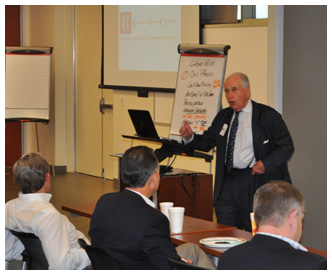After I posted my thoughts on blue collar workers, this is one of the comments I received on Scott Braddock: A Voice for Texas from a reader:“It is not just the academic types who devalue blue collar labor but corporate number crunchers who assume one set of hands is as good as another when it comes to these sorts of jobs and work to literally devalue the job by paying less, ignoring safety and job conditions and assuming there will always be fresh bodies to fill the position. Problem is that when management develops that level of disdain for workers,
Reshaping the Construction Industry


This is the second in the series about the Construction Bandits and how they do business in a way that cheats many workers and ultimately you, the taxpayer.An article by Karl Kiefer appeared in September of 2009 in NumbersUSA under Charles Breiterman’s blog which was entitled, Mixing the Mud: A Working Man’s Views on Illegal Immigration, Tricks of The Trade. Immigration is not part of our discussion here, rather we wanted to illustrate how the Bandits in our industry get around the existing laws. We want you to be aware of those illegal practices and we want you to join our efforts to create a more sustainable workforce for the industry.Kiefer points out one way that the Bandits get around the insurance costs is to lie about the number of workers they have on their crews or to buy coverage for only one or two of their crew. Conveniently, the “covered” workers are the only ones ever injured on the jobsite even though that is far from the truth.Another way that they cheat is to misclassify the workers as independent contractors and to pay the workers’ wages with cash without paying taxes and unemployment (FUTA and SUTA). When they don’t pay Federal or State income taxes, they are cheating us out of tax funds that the country desperately needs today.
May 30, 2012


Over the weekend, San Francisco residents and visitors celebrated the 75th anniversary of the completion of the iconic Golden Gate Bridge. The longest suspension bridge in the world at the time, the mile-long bridge was constructed from 1933 to 1937 – a sign of optimism during the Great Depression when many Americans were unemployed.According to David Muir in the ABC World News video below, many believed that due to the dangerous wind conditions and ocean currents through the Golden Gate Strait, the bridge could not be built. The brave construction workers who often worked without harnesses with only a “safety net” stretched between them and the ocean proved the naysayers wrong.
May 29, 2012
Recently, representatives from Construction Citizen (including myself) visited the offices and training facilities of SER-Jobs for Progress, guided by executive director Nory Angel. One of the programs offered by SER is their Green Jobs Training Project, which they provide in partnership with several other organizations including Workforce Solutions, Houston Community College, Home Builders Institute, Houston Works USA, and Fifth Ward Enrichment Program for Green Training Programs. They provide training at no cost to eligible individuals which includes career coaching and is followed by pre-employment services and referrals to help the graduates find work after completing one or more of the offered courses. The program is provided to extremely low-income adults who live in the Houston community.
May 23, 2012


The Construction Career Collaborative (C3) held their third update workshop in Houston in which they reported on their progress to date on this leading edge program to create a sustainable construction workforce.The organization is in its early development phase and is in the midst of two major pilot construction projects being undertaken by Texas Children’s Hospital and theMD Anderson Cancer Center. These owners will require everyone on the jobsite to meet the C3 standards of financial security for the workforce, safety training, and craft training for the industry. In essence, meet and exceed the existing labor laws for the industry, eliminate wage theft and misclassification, and minimize the “grey” economy that exists in many parts of the construction industry today.Owners, general contractors, specialty subcontractors, and industry representatives
May 23, 2012


Scott Braddock is a broadcast journalist whose recent experience with unemployment sparked a very personal interest in the employment outlook in Texas. This week he posted a blog on his website entitled “The Value of Blue Collar Work” in which he writes about many of the issues which have also been discussed on Construction Citizen. He understands that not all careers begin with a four-year college degree, partly due to his own story. He writes:“I don’t have a college education but I am trained as a journalist. Over the years, companies large and small have prepared me to report and cover stories and trends. My on-the-job training is worth more to me than a college degree might ever have been in my chosen field.”Braddock includes a link to a 9-minute video of Evan Smith of The Texas Tribune interviewing state Senator Dan Patrick (R-Houston) earlier this month about changes he believes are needed in the education system, and the need for “blue collar work” to be appreciated and pursued. Patrick is quoted as saying:
May 21, 2012


While driving from San Antonio to Houston this week, I came up on two cars that seemed to be traveling slower than the rest of us, and they were swerving from their lane over into mine. Usually when I run up on someone who acts like they might be drunk I speed up and go around them so that they don’t cause a problem. This was unusual since there were two cars traveling almost in a caravan down I-10.As I sped up and started by them, I noted a couple of things. The driver of the first car was texting at 75 miles per hour and not exactly looking at the road. That was scary enough but as I passed the second car, I saw something that looked like a video on a smartphone in the hands of the driver.
May 17, 2012


John Killin, president of the Associated Builders and Contractors’ Pacific Northwest chapter and executive director of the Independent Electrical Contractors of Oregon, published an interesting article in Oregon’s Daily Journal of Commerce on the future of the skilled workforce.He issues a call to action that now is the time to begin the hiring and training of the skilled workforce for the future. He writes:“Years are required to prepare people for the leadership roles they will fill in the future. In licensed trades, years are needed to simply move someone from entry level to license-in-hand, full journey-level status.“Contractors that are beginning to add workers should be sure apprenticeship is at the top of their hiring priorities.
May 17, 2012


An article in the Washington Post by Lonnae O'Neal Parker reported that yesterday a revised design for the National Eisenhower Memorial was presented to the Eisenhower Memorial Commission for consideration. If approved, the proposal will be sent on to the National Capital Planning Commission as the next step toward building the $110 million memorial to Dwight David “Ike” Eisenhower near The National Mall in Washington, DC. The original design by architect Frank Gehry received criticism from Eisenhower’s family members and design traditionalists. Gehry has modified his design, and planners now hope to break ground on the project later this year.
May 16, 2012


According to a report released last fall by the Money Service Business Facilitated-Workers’ Compensation Fraud Work Group in the State of Florida, “Workers’ compensation fraud is a serious problem.” Not just in Florida, but in any state where there are folks working for cash in the underground economy and where there are check cashing services willing to play the insurance premium fraud game. According to the report,“This type of fraud is most prevalent in the construction industry where a high percentage of the labor force is transient. The costs to the system for this type of fraud include unreported payroll taxes, unreported premium taxes, and higher costs to insurance carriers who must process workers’ compensation claims for uninsured workers. It is estimated that the costs of this type of fraud could cost the state upwards of $1 billion annually, and places tremendous pressure on law-abiding businesses to absorb the costs of premium avoidance.”
May 10, 2012



.jpeg?itok=6uFZXEBH)





.jpeg?itok=4Vi_1nJG)












